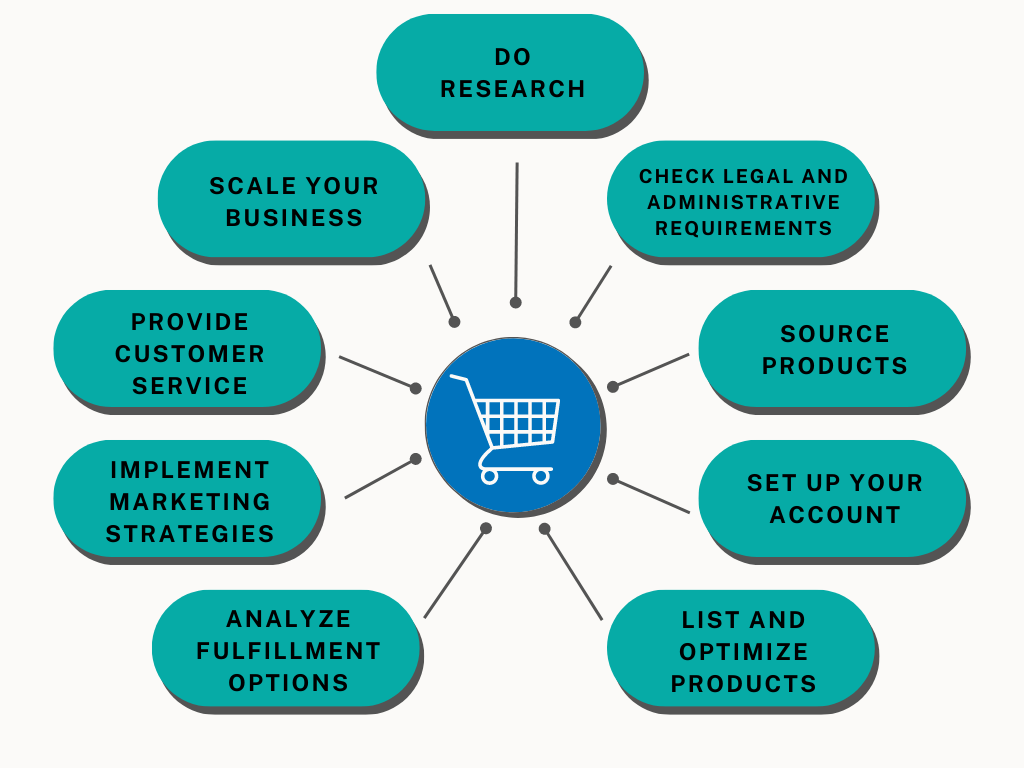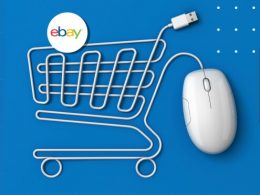In today’s rapidly evolving e-commerce business landscape, Amazon stands out as a powerhouse platform, offering immense opportunities for entrepreneurs to reach a global customer base. If you’re considering becoming an Amazon seller, you’re on the right path to tap into this thriving marketplace. In this comprehensive guide, we’ll walk you through the essential steps and strategies to embark on your journey as an Amazon seller.

Do all the research and preparation before you sell products on Amazon
So, how to become an Amazon seller? Before diving into the Amazon marketplace, it’s crucial to conduct thorough research and prepare a solid foundation for your business. Start by identifying profitable product categories by analyzing market trends and consumer demand. Look for niches where there is high demand but relatively low competition. Assess the competitive landscape by studying existing sellers, their pricing strategies, product features, and customer reviews. This research will help you identify gaps in the market and make informed decisions about the products you choose to sell.
Once you have a clear understanding of your target market on Amazon and potential products, it’s time to formulate a business plan. Define your goals, marketing strategies, and financial projections. A well-thought-out plan will guide your decisions and attract potential investors or partners if needed.
Check legal and administrative requirements
Ensure you comply with legal and administrative requirements to establish a legitimate business presence. Start by registering your business entity with the appropriate government authorities. Research the specific requirements based on your country or region, as they may vary. Obtain any necessary licenses or permits, such as a reseller’s permit or a sales tax license, depending on your jurisdiction and the type of products you plan to sell.
Setting up a dedicated bank account for your Amazon business is essential for financial management. Separating your personal and business finances simplifies bookkeeping and makes tax reporting more accurate.
Consider consulting with an accountant or tax professional to understand your obligations and ensure compliance with tax regulations.
Plan how you’ll handle product sourcing and inventory management
Once you’ve identified the products you want to sell on Amazon, it’s time to source them. There are several options available, including selling existing products, creating your own brand, or leveraging wholesale suppliers. If you choose to sell existing products, research reputable suppliers and negotiate favorable terms to ensure a consistent supply of inventory.
For those considering developing a private label brand, work closely with manufacturers or suppliers who can customize products to your specifications. Conduct thorough due diligence to ensure the quality and reliability of your suppliers. Consider ordering samples to assess the product’s quality before making a larger investment.
Inventory management is crucial for successful Amazon selling. Overstocking can tie up your capital, while understocking can result in missed sales opportunities. Utilize inventory management tools or software to track stock levels, analyze sales patterns, and forecast demand on Amazon. This data-driven approach will help you make informed decisions about inventory replenishment and prevent stockouts.
Learn about Amazon storage and fulfillment fees and reselling on Amazon.
Set up an Amazon seller account
To start selling on Amazon, you need to create an Amazon seller account. Decide whether you want to register as an individual seller or a professional seller, depending on your business needs. An individual seller account suits those planning to sell a limited number of items, while a professional seller account is suitable for those with higher sales volume and more extensive product catalogs.
To create an Amazon seller account, visit the Amazon Seller Central website and follow the step-by-step instructions. Provide accurate and detailed information about your business, including contact information, product categories, and payment details. It’s crucial to make sure that all the information is valid, otherwise you may experience issue with you amazon account on hold later. Familiarize yourself with Amazon’s policies and guidelines to ensure compliance and prevent potential account suspensions or other issues.
List and optimize products on Amazon
Optimizing your product listings is crucial for visibility and attracting potential buyers. Conduct thorough keyword research to identify relevant search terms that customers are likely to use when looking for products on Amazon. Utilize keyword research tools such as Google Keyword Planner to identify high-volume and low-competition keywords.
Incorporate these keywords strategically into your Amazon product titles, bullet points, descriptions, and backend search terms. Craft compelling and concise product titles that accurately describe your product’s key features and benefits while incorporating relevant keywords. Use bullet points to highlight the unique selling points of your product and its main features. Write persuasive and informative product descriptions that address customer pain points and showcase the value your product offers.
In addition to optimizing text, high-quality product images play a vital role in attracting customers. Invest in professional product photography or use high-resolution images that clearly showcase your product from multiple angles. If you’re unsure where to begin, learn how to set up product photography to ensure your images are well-lit, clean, and visual apprealing. Include lifestyle images that demonstrate product usage and create an emotional connection with potential buyers.
Videos have become increasingly popular on Amazon product listings. Consider creating engaging product demonstration videos or explainer videos that highlight the features, benefits, and use cases of your product. Videos not only enhance the customer’s understanding of your product but also boost conversion rates.
Pricing is another critical aspect of listing optimization on Amazon. Research your competitors’ pricing strategies on Amazon to ensure your pricing is competitive within your product category. While it’s tempting to undercut competitors, it’s important to maintain a healthy profit margin. Experiment with pricing strategies such as offering discounts, bundling products, or providing value-added incentives to attract customers.
Analyze fulfillment options and shipping strategies available: Amazon FBA and Amazon FBM
One of the key advantages of selling on Amazon is its robust fulfillment infrastructure. Amazon offers two main fulfillment options: Fulfilled by Amazon (FBA) and Fulfilled by Merchant (FBM).
Amazon FBA allows you to store your products in Amazon’s fulfillment centers. When a customer places an order, Amazon handles the picking, packing, shipping, and customer service. This option gives you access to Amazon Prime customers and provides a seamless shopping experience. However, FBA comes with storage and fulfillment fees, so it’s important to factor in these costs when pricing your products.
Learn how to become an Amazon FBA seller.
Amazon FBM involves fulfilling orders directly from your own warehouse or a third-party fulfillment center. This option gives you more control over the fulfillment process, but you’ll be responsible for inventory storage, order fulfillment, and customer service. It can be a cost-effective choice for Amazon sellers with smaller product catalogs or unique product offerings.
When setting up your Amazon shipping strategy, consider factors such as product weight and dimensions, shipping carrier options, and customer expectations. Research shipping rates and negotiate discounted rates with carriers to optimize your shipping costs. Offering fast and reliable shipping options, including free shipping or Prime-eligible shipping, can significantly improve your chances of winning the Buy Box and attracting customers.
Implement marketing and advertising strategies
It’s important to implement effective digital marketing and advertising strategies to drive traffic and increase sales on Amazon.
Amazon offers a range of advertising tools to promote your products. Sponsored Products, Sponsored Brands, and Sponsored Display Ads allow you to bid on keywords and display your products prominently in search results and product detail pages. These ads can significantly increase your product’s visibility and drive targeted traffic to your listings.
Off-Amazon marketing strategies can also complement your Amazon efforts. Establish a strong social media presence and engage with your target audience on platforms such as Instagram, Facebook, or YouTube. Create content that showcases your products and provides value to your followers. Collaborate with influencers or bloggers in your niche to reach a wider audience and generate product awareness.
Utilize social and email marketing to build a customer base and nurture relationships with existing customers. Implement strategies such as offering exclusive discounts, launching new product announcements, or requesting product reviews. Building a loyal customer base can lead to repeat purchases and positive word-of-mouth recommendations.
Provide excellent customer service to get reviews
Providing exceptional customer service is crucial for success on Amazon. Promptly respond to customer inquiries and messages to demonstrate your commitment to customer satisfaction. Aim to provide timely and helpful responses, addressing any questions or concerns they may have.
Handle returns and refunds efficiently and in accordance with Amazon’s policies. Clear and transparent communication with customers on Amazon throughout the return process is essential to maintain their trust and satisfaction.
Encourage customers to leave reviews and feedback by following Amazon’s guidelines. Positive reviews can significantly impact your product’s visibility and conversion rates. Utilize Amazon’s automated feedback request system or consider using third-party tools to send personalized follow-up emails requesting reviews. However, remember to abide by Amazon’s policies and avoid incentivizing or manipulating reviews, as it can lead to account suspension.
Negative reviews on Amazon are inevitable, and how you handle them is crucial. Respond to negative reviews promptly and professionally, demonstrating your commitment to resolving any issues. Address the customer’s concerns and offer solutions or alternatives if possible. Potential buyers often consider how sellers handle negative feedback, and a thoughtful and considerate response can turn a negative experience into a positive one.
Analyze performance
Regularly monitor and analyze your Amazon sales performance to gain insights into your business. Analyzing these metrics will help you identify trends, measure the effectiveness of your strategies, and make data-driven decisions.
As your Amazon business grows, consider expanding your product offerings and exploring international marketplaces. Amazon provides opportunities to sell globally through programs like Amazon Global Selling. Research and adapt to local market preferences, regulations, and cultural nuances to expand into new markets successfully.
Scaling your e-commerce business requires careful planning and resource management. As you increase your Amazon product catalog, evaluate your inventory management systems and consider investing in inventory forecasting tools. Streamline your operations by optimizing processes, outsourcing non-core tasks, or leveraging fulfillment services. Scaling your business also involves expanding your team or partnering with reliable service providers to handle customer support, logistics, and other essential aspects of your business.
Consider implementing a third-party solution that’ll provide you with a comprehensive overview of your Amazon business performance. Software such as Synder Business Insights allows its users to scale the most important metrics, such as COGS, AOV, LTV, etc., on the dashboard.
Keep track of your Amazon performance and make strategic decisions based on the real numbers – visit the Synder webinar to learn more about how it works.
Conclusion: Is it worth to start selling on Amazon?
Becoming an Amazon seller opens doors to a world of e-commerce possibilities. By following the step-by-step guidelines outlined in this comprehensive guide, conducting thorough research, and implementing effective strategies, you’ll be well on your way to establishing a successful presence on Amazon.
However, it’s important to remember that success on Amazon requires dedication, adaptability, and continuous learning. The e-commerce landscape is dynamic, and staying updated with market trends, consumer preferences, and Amazon’s policies is essential. Embrace the challenges, monitor your performance, and iterate your strategies based on data-driven insights.
Embark on your Amazon seller journey today and unlock the vast potential that awaits in the world of e-commerce. With perseverance, strategic planning, and a customer-centric approach, you can build a thriving business on Amazon and realize your entrepreneurial aspirations.
Learn about specific topics such as Selling books on Amazon

.png)




